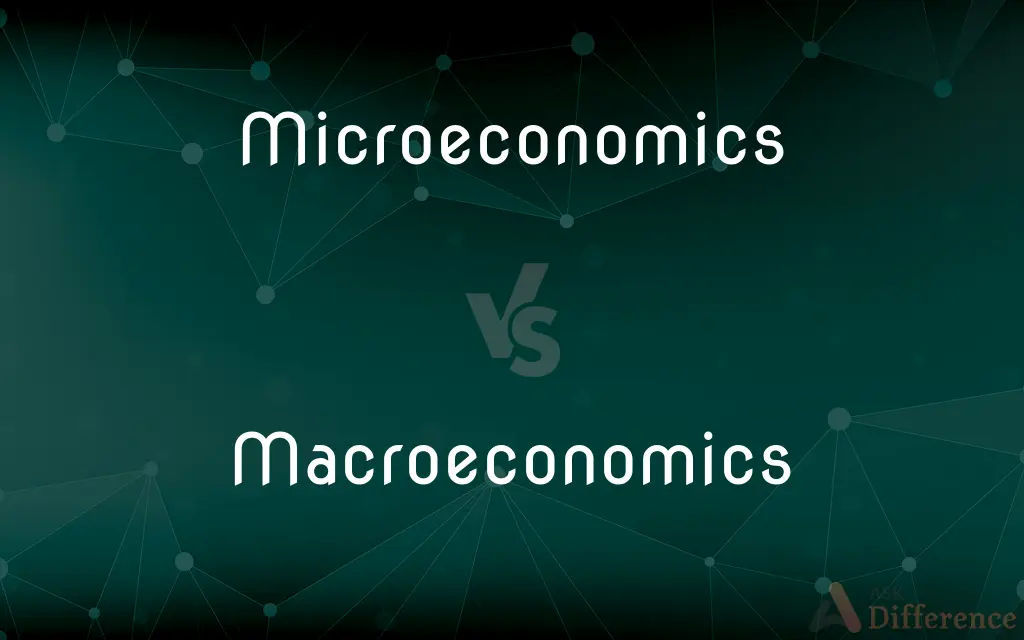Microeconomics vs. Macroeconomics — What's the Difference?
Edited by Tayyaba Rehman — By Fiza Rafique — Updated on March 15, 2024
Microeconomics focuses on individual and business decision-making processes and their interactions in specific markets. Macroeconomics examines the economy as a whole, including total output, employment, inflation, and economic growth.

Difference Between Microeconomics and Macroeconomics
Table of Contents
ADVERTISEMENT
Key Differences
Microeconomics delves into the behaviors of individuals, households, and firms, exploring how they make decisions regarding the allocation of limited resources. It studies the mechanisms of supply and demand in various markets, determining prices and quantities of goods and services. On the other hand, macroeconomics looks at the economy from a wide lens, focusing on aggregate indicators like GDP, unemployment rates, and price indices to understand overall economic health and growth.
Microeconomics also investigates market structures (like perfect competition, monopoly, and oligopoly), consumer behavior, and factors influencing firms' production and pricing strategies. This branch of economics provides insights into how economic entities interact within markets and the outcomes of these interactions, such as market efficiencies or failures. Macroeconomists analyze national economic policies, including fiscal policies (government spending and taxation) and monetary policies (central bank actions), and their impact on economic stability and growth.
One of the key differences lies in their respective scales and focus areas. Microeconomics is concerned with the "trees," studying specific components of the economy and their interactions, while macroeconomics is about the "forest," examining the economy as a whole. For instance, while microeconomics might analyze how the price of coffee affects consumer choices and coffee shop profits, macroeconomics would be interested in how the coffee industry contributes to national GDP or is affected by inflation.
The relationship between micro and macroeconomics is interdependent and complex. Microeconomic principles, such as the behaviors of consumers and firms, underpin macroeconomic outcomes like aggregate demand and inflation. Conversely, macroeconomic trends and policies can significantly impact microeconomic behaviors, as seen in how inflation rates can influence individual spending decisions or how fiscal policies can affect business investments.
Both microeconomics and macroeconomics offer valuable perspectives for understanding economic phenomena. Microeconomics provides the foundational building blocks of economic theory by focusing on individual components, while macroeconomics offers a broader view, addressing economic issues at a national or global scale. Together, they encompass the full spectrum of economic analysis, contributing to our understanding of how economies operate and are managed.
ADVERTISEMENT
Comparison Chart
Focus
Individual, households, and firms' decision-making
Economy-wide phenomena such as inflation, unemployment, and GDP
Key Concepts
Supply and demand, market structures, consumer behavior
Aggregate demand and supply, fiscal and monetary policy, inflation
Scale
Specific markets and industries
The overall economy
Analysis
Price formation, production decisions, market efficiency
Economic growth, stability, policy impacts, international economics
Policy Considerations
Market regulations, antitrust laws, consumer protection
Taxation, government spending, central banking policies
Compare with Definitions
Microeconomics
Study of individual economic agents and markets.
Analyzing how a price increase in milk affects consumers and dairy farmers.
Macroeconomics
Analysis of the economy as a whole.
Assessing how government stimulus affects national GDP growth.
Microeconomics
Looks at market structures and failures.
Studying the effects of monopoly power in the tech industry.
Macroeconomics
Studies aggregate indicators like GDP and inflation.
Examining the factors leading to an increase in the inflation rate.
Microeconomics
Investigates consumer and producer behavior.
How consumer preferences for electric cars influence automotive industry trends.
Macroeconomics
Focuses on national economic policies.
The impact of changes in interest rates set by the Federal Reserve on the economy.
Microeconomics
Concerned with resource allocation and optimization.
How businesses decide on the optimal level of production based on costs.
Macroeconomics
Addresses economic growth and stability.
Strategies for reducing national unemployment rates.
Microeconomics
Focus on supply, demand, and price mechanisms.
Examining the impact of smartphone innovation on market competition.
Macroeconomics
Considers international trade and finance.
The effects of exchange rate fluctuations on global economic balance.
Microeconomics
Microeconomics is a branch of economics that studies the behavior of individuals and firms in making decisions regarding the allocation of scarce resources and the interactions among these individuals and firms.One goal of microeconomics is to analyze the market mechanisms that establish relative prices among goods and services and allocate limited resources among alternative uses. Microeconomics shows conditions under which free markets lead to desirable allocations.
Macroeconomics
Macroeconomics (from the Greek prefix makro- meaning "large" + economics) is a branch of economics dealing with the performance, structure, behavior, and decision-making of an economy as a whole. For example, using interest rates, taxes, and government spending to regulate an economy’s growth and stability.
Microeconomics
The study of how businesses, households, and individuals within an economy allocate limited resources.
Macroeconomics
The study of the overall aspects and workings of a national economy, such as income, output, and the interrelationship among diverse economic sectors.
Microeconomics
The field of economics that deals with small-scale economic activities such as those of an individual or company.
Macroeconomics
The study of the entire economy in terms of the total amount of goods and services produced, total income earned, the level of employment of productive resources, and the general behavior of prices.
Microeconomics
The branch of economics that studies the economy of consumers or households or individual firms
Macroeconomics
The branch of economics that studies the overall working of a national economy
Common Curiosities
How does macroeconomics differ from microeconomics in its approach?
Macroeconomics takes a broader approach, examining the economy as a whole, including aggregate measures like GDP, national income, and inflation, to understand overall economic trends and policy impacts.
What is the primary concern of microeconomics?
Microeconomics focuses on how individual consumers, households, and firms make decisions to allocate resources, particularly in dealing with the dynamics of supply and demand in specific markets.
Can microeconomic principles be applied to macroeconomic issues?
Yes, microeconomic principles underpin many macroeconomic phenomena; for instance, individual spending behaviors (a microeconomic concern) contribute to aggregate demand (a macroeconomic issue).
How do macroeconomic factors influence an individual's daily life?
Macroeconomic factors like inflation rates, employment levels, and economic growth can significantly impact an individual's purchasing power, job security, and overall economic well-being.
How do government policies differ in their focus between micro and macroeconomics?
In microeconomics, policies may focus on regulating specific markets, promoting competition, and protecting consumers, whereas in macroeconomics, policies typically aim to influence overall economic growth, stability, and inflation through fiscal and monetary measures.
Why is the study of both micro and macroeconomics important?
Studying both fields is crucial for a comprehensive understanding of economics, as microeconomics provides insight into the behaviors of individual economic agents, while macroeconomics offers a broader perspective on national and global economic trends.
What role does microeconomics play in business decision-making?
Microeconomics is crucial in business decision-making, as it helps firms understand market conditions, consumer behavior, and pricing strategies to optimize production and maximize profits.
Can macroeconomic trends affect global economies?
Yes, macroeconomic trends in one country can have significant effects on global economies through trade, investment flows, and financial markets, highlighting the interconnectedness of national economies.
What is an example of a microeconomic study?
An example would be analyzing how the introduction of a new technology affects pricing and consumer choice within the smartphone market.
What is the significance of market structures in microeconomics?
Market structures (such as perfect competition, monopoly, oligopoly) are significant in microeconomics because they influence how prices are set, how markets operate, and the level of competition within industries.
How do fiscal and monetary policies fit into macroeconomic analysis?
Fiscal (government spending and taxation) and monetary (central bank policies) policies are key tools in macroeconomic analysis, used to manage economic growth, control inflation, and stabilize the economy.
Share Your Discovery

Previous Comparison
Story vs. Script
Next Comparison
Province vs. TerritoryAuthor Spotlight
Written by
Fiza RafiqueFiza Rafique is a skilled content writer at AskDifference.com, where she meticulously refines and enhances written pieces. Drawing from her vast editorial expertise, Fiza ensures clarity, accuracy, and precision in every article. Passionate about language, she continually seeks to elevate the quality of content for readers worldwide.
Edited by
Tayyaba RehmanTayyaba Rehman is a distinguished writer, currently serving as a primary contributor to askdifference.com. As a researcher in semantics and etymology, Tayyaba's passion for the complexity of languages and their distinctions has found a perfect home on the platform. Tayyaba delves into the intricacies of language, distinguishing between commonly confused words and phrases, thereby providing clarity for readers worldwide.
















































